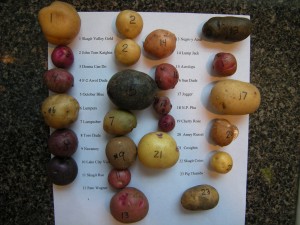This topic appears in various forms around the Internet, and is always presented as a list of questions and answers with a perversely commercial twist. As if we didn’t know they were trying to get us to go out and buy more useless stuff. Anyway, while it’s many other places as well, I’ve borrowed these quotes below from here.
I’ve purposely skipped over the points I didn’t find interesting, which is why some of the numbers are missing.
Here is my response to their response to our previously stated concerns…
1. Low-energy bulbs produce unpleasant light
Five or so years ago, many low energy bulbs did produce rather weak, cold and unnatural-looking light. But times have changed and modern eco bulbs are better than ever before.
American magazine Popular Mechanics put such claims to the test, asking people to rate the light from eight different bulbs. The result? The seven eco bulbs all scored better than the one regular bulb.
Many people continue to complain about the quality of light from these bulbs, still! I personally find them very harsh, and at the high end do not do an adequate job of lighting up a room as a supposedly comparable regular bulb. I think rather than continue to tell us the light is no longer unpleasant, like they’ve been saying for years now, manufacturers need to simply start making more pleasant bulbs and people will start buying them.
2. Eco bulbs flicker and take ages to turn on
Again, this is mainly a thing of the past. Most modern low-energy bulbs turn on within a second, with no flickering. But it’s true that they can take a few seconds to reach their maximum light levels, especially in a cold room.
I think it’s pretty clear, they do still sometimes flicker and they do take a long time to turn on. Especially taking a while to come up to full brightness, I find very annoying. Time will tell as the newer bulbs wear out, but all the previous generations have started flickering and dimming as they got old, and I can’t see any reason not to suspect the same will happen with the newer ones.
3. Low-energy light bulbs are expensive
Prices have plummeted in recent years and, thanks to subsidy schemes, high quality bulbs are available in the UK for as little as £1 each. The more obscure eco bulbs are pricier, but still excellent value if you factor in how long they last and the comparative cost of using regular bulbs.
I think this is pretty expensive! Standard bulbs cost just a few cents. What’s also the problem is you just don’t know what you’re paying for with the newer bulbs. If you buy a cheap one at a market somewhere, will you be punished? Will the light be blue? Will it start flickering after a few hours of use or just burn out completely? With the older bulbs, you know what you are buying and there are few risks in buying a cheap one.
For some time now the manufacturers of the newer bulbs have manipulated us into buying and rebuying bulbs that were of poor quality, and we’re supposed to believe them now? At best the idea the new bulbs last longer is very dubious, and my experience is they are far from value for money.
In addition, traditional bulbs can be manufactured with the idea of lasting longer, but now there is a lot of pressure to make electricity-efficient bulbs. This results in bulbs that burn out faster and probably consume more energy in total.
4. Low-energy bulbs take lots of energy to make, offsetting their environmental benefits
Energy saving bulbs take around four times more energy to make than regular incandescent bulbs do. But they last five to ten times longer, so they can actually help reduce the total energy used in light bulb manufacture and distribution. Even if this were not true, the energy used in producing an eco bulb would be outweighed by the 80 per cent energy savings it can make.
The problems with this argument are numerous. First of all it’s pretty clear the claim of 80% energy savings with the new bulbs is little more than a lie. It varies from bulb to bulb, but 60% is probably a lot more realistic. You’ll notice this claim is not made much any more, and there have been threats of legal action for manufactures who use it in their marketing.
In addition, the manufacturing energy costs do not take into account that the new bulbs come from China, where the old ones were made locally in many places like Europe and the US. These energy costs also don’t take into account recycling and disposal costs that were not necessary with the older bulbs. Consider too that many people will be recycling the newer bulbs by taking them somewhere in their car.
7. Low-energy bulbs don’t work with dimmer switches
This was true until recently, but you can now buy fully dimmable low-energy lights (see Varilight and Osram). They’re more expensive than regular eco bulbs but they can still save you plenty of money in the long run. Also, the Philips energy-saving halogen bulbs mentioned above are fully dimmable (as are some Megaman bulbs, though you may have to change your fittings).
I think the real question is, if you want a dimmable light, why not use a regular bulb? Why is it necessary to go out and buy a very expensive bulb of dubious quality, in order to have a dimmable lamp in your home??
8. Low-energy bulbs are bad for us and the environment as they contain mercury
It’s true that low-energy bulbs contain tiny quantities of mercury (around 100-300 times less than you’d get in a thermometer). However, this can be safely disposed of by taking old bulbs to your local dump for recycling. It is important not to throw bulbs into landfill as mercury is harmful if it enters water courses and the food chain.The largest source of mercury in the air is the burning of fossil fuels – in coal-fired power plants, for example. So, provided they’re properly disposed of, low-energy bulbs can actually help to reduce the amount of mercury energy entering the atmosphere by cutting the demand for electricity.
The problem is not mercury in the environment, the problem is mercury in our homes! Mercury is poisonous and no safe level has been established for human exposure. If these newer bulbs break they spread the mercury around our homes. If someone throws one of these bulbs on the ground or it gets buried, the mercury will leach out and remain effectively forever. If someone grows their food on that ground, the mercury will be taken up by the plants. It’s chemical waste, and if the ground gets contaminated, it needs to be cleaned up.
In order to deal with this waste the consumer needs to turn the bulbs in for disposal, which should not be their responsibility and involves more wasted energy.
Traditional light bulbs don’t have poisonous waste in them, and special recycling is not necessary.
What do coal-fired power plants have to do with this argument anyway??
9. Regular bulbs don’t waste energy, they just produce heat that helps warm the home
It is true that the ‘wasted’ energy of a regular bulb is given off as heat but this is only useful on cold days. Gas boilers produce heat far more efficiently than electric light bulbs. And as hot air rises, bulbs on the ceiling aren’t exactly the ideal place to produce heat for your home.
I don’t know many people who heat their homes with light bulbs, do you?
The question is not if this is a sensible thing to do, the issue is if the wasted energy from less efficient bulbs gets at least partly offset by your home heating system. Since darkness and cold weather go together in most parts of the world that experience a winter climate, it’s a very common situation where people use light bulbs at the same time as their central heating. Sunlight generates heat and light, and lack of sunlight generally means the need for lighting and heating.
‘Gas boilers produce heat far more efficiently than electric light bulbs’ is a very subjective statement. In my case for example, my electricity comes from a nearby gas fired power plant that’s very efficient. Other people may have wind generated or other ‘green’ electricity, that’s actually more environmentally friendly than a gas boiler.
Even though the light bulbs are usually on the ceiling, electricity lost from low efficiency is not lost, it’s converted to heat that heats your house together with your central heating system. There is some energy lost because gas heating is more efficient than electricity, but for many people this could be as little as 20%, meaning very little difference in total between newer and older light bulbs.
The real issue here is that the amount of energy used to light the average home is very small compared to the energy used for airco and heating, and in the case of heating a percentage of this is offset when you use lights. While wasted energy is important, the emphasis being put on low energy lighting is disproportionate to what lighting consumes. The real issue is manufactures are trying to trick and force us into buying more things that are a disposal problem and we don’t need.
If you were to do a true and honest assessment of the energy difference between new and old bulbs, including all of my points here, I think you would find the newer bulbs consume more energy overall — in addition to creating a disposal problem. In any event the difference in energy consumption is not huge.
I’m not saying it’s bad to use the new bulbs, but you have to consider your personal circumstances carefully, and they are not for everyone.



 With the recent announcement by
With the recent announcement by 



